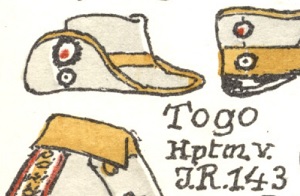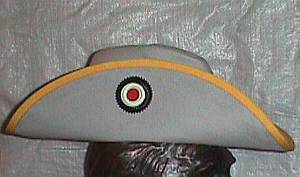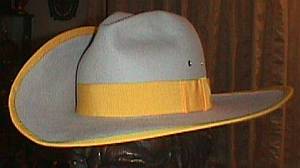|
Togo Südwester Hat 1912-14
The Schutztruppe uniform
regulations of 1912 authorised yellow as the colour for the hatband and edging
of the Südwester hat and field cap for German army officers seconded to Togo. At the same
time green was authorised for those in New Guinea and Salmon Pink for those in
Samoa. Officers on secondment from the German army wore a small state cockade of
their home regiment below the Südwester large Imperial cockade.
Several Südwester hats and a few
uniforms have
turned up with yellow edging in modern private collections and online auctions. All claim to be from Germans serving in Togo.
This is surprising as very few
German officers served on secondment to Togo between 1912 and the fall of the
colony two years later. At any one time, there were no more two army officers
deployed there. If they served six month tours of duty, only eight men can ever
have been authorised to wear the yellow piping, perhaps less.
None of these officers have yet been
seen in period photographs yet up to half a dozen such items have been seen in
modern collections.
Chinese Veteran's Südwester Hat 1920s-40s
There is however another explanation
for some of the yellow trimmed hats and uniforms that appear in modern
collections. In the 1920s overseas veterans of the Deutsche Kolonialkriegerbund or
DKKB were authorised new khaki uniforms loosely
based on those of the Schutztruppe. With them they wore the grey felt Südwester
hat with a single large German cockade.
Whereas previous Schutztruppe khaki uniforms were
piped in blue for all colonies, the new tunics and trousers were piped in colony colour. The Südwester
also had its hatband and edging in the colony colour.
Colony colours for the
three larger African colonies were the same as previously (blue for South West Africa,
white for East Africa and red for Cameroon). However whereas the 1912
regulations gave Togo, New Guinea and Samoa their own colony colours the
veterans from these colonies now all wore green. Yellow was the colour now worn
by veterans of service in China, mainly from the East Asian Expeditionary Corps
and III. Seebataillon.
This would certainly explain the relatively high
number of yellow trimmed hats (often without state cockades) and yellow piped
uniforms (sometimes bearing the 1900 China Campaign Medal) that appear in the
modern collections.
|
|

Yellow Edged Südwester and Uniform of an Officer on Secondment to
Togo
Südwester, Field Cap and
Greatcoat of a Hauptmann of the 143rd Lower Alsace Infantry Regiment on
secondment to Togo. Note the small Prussian cockade worn by soldiers
from Alsace and Lorraine
Illustration from "Das Deutsche Heer,
Friedensuniformen bei Ausbruch des Weltkrieges " by H. Knötel and P.
Pietsch (Diepenbroick-Grüter & Schulz, Hamburg 1935)

Yellow Edged Südwester
Note the lack of a state cockade
Photo from Ebay

Yellow Edged Südwester
Photo from Ebay |